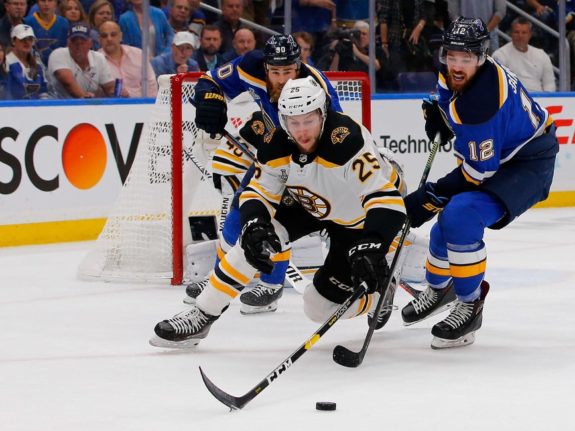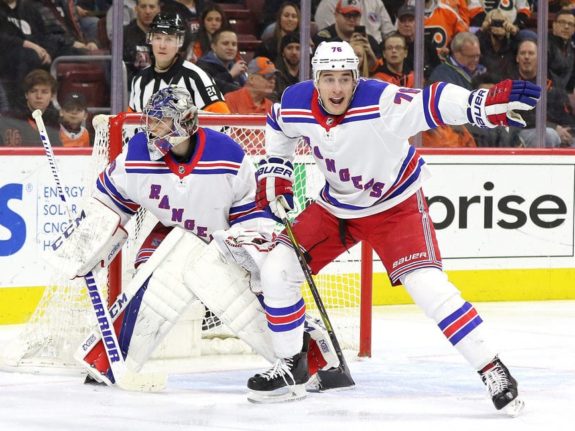For Boston Bruins fans, there’s still a hope that top restricted free agent defensemen Brandon Carlo and Charlie McAvoy will sign soon and fit in the just-under $12 million in cap space the team would have running a bare-bones (18 skater) roster.
Sadly, and thanks to a major step forward by Carlo in the 2019 Stanley Cup Playoffs, this appears less and less likely.
McAvoy was always going to come in at $7-8 million, if not more. His performance in the postseason coupled with the already-signed Jacob Trouba’s $8 million AAV (average annual value) made that abundantly clear. So, the Bruins are probably already hamstrung with $4.5 million or less available for Carlo.
But Carlo is better than that.
Sure, he’s a mediocre offensive threat (though that part of his game may in fact be growing), but his work in his own zone in defending key opposing threats, negating opportunities and producing excellent zone-exit chances; all deem him more than just a ‘solid’ second-pairing stud.

Stats Back up Brandon Carlo
And the underlying numbers back that up. According to Evolving-Hockey, Carlo’s regular season on-ice expected goal differential at even strength (6.23 on-ice-xGD) was 45th out of 351 defensemen who skated at 5-on-5 last season. That puts him square in the middle of No. 2 defensemen range (not second pairing, where he’s often placed due to his spot behind McAvoy).
Similarly, at Evolving-Hockey, their goals above replacement tool has him spotted at 43rd in wins above replacement (1.4 WAR) and 46th in goals above replacement (7.7 GAR). His 7.5 GAR at even strength even puts him on the line of a No. 1 defenseman (33rd overall).

Whether it’s closing gaps, producing viable zone-exits or simply helping defensive partner Torey Krug rack up impressive shot and goal differentials, Carlo’s presence exudes the type of calm yet dynamic stay-at-home prowess that few defensemen around the league can project.
But all that doesn’t necessarily mean big bucks. Defensemen without high offensive upside rarely cash in like their high scoring, break the bank partners. Trouba, for all his defensive ability, just came off a season where he scored above 50 points to earn that $8 million AAV.
In fact, of the top 50 NHL defensemen by 2019-20 cap hit, 30 were among the top-50 in scoring last season. Among the others were tried-and-true defensive stalwarts (e.g., Marc-Edouard Vlasic, Brady Skjei, Hampus Lindholm), players significantly underperforming their contracts (e.g, Marc Staal, Brent Seabrook, Cam Fowler), and players who missed significant chunks of the season (e.g., Justin Schultz, Anton Stralman). Hence, players without significant offensive upside who have defensive prowess in this grouping – where Carlo belongs – were few and far between.
Looking at Brady Skjei to Compare
The contract I look at most closely is that of the aforementioned Skjei. He’s not the same player that Carlo is by GAR but he was coming off of back to back seasons with 25-plus points (including a rookie campaign where he scored 39) and was widely regarded as a defensive stud. The New York Rangers, with space to burn, signed him to a six-year, $5.25 million AAV deal that was worth 6.6% of the salary cap.

Using the same cap percentage for Carlo this offseason gives us a cap hit of $5.38 million. That’s more than the Bruins have to spend, but it remains well worth it for a defenseman of his caliber. Perhaps, given the cap crunch, the Bruins could get him down to $5 million AAV but that’s about the lower limit of my expectations regarding Carlo.
With McAvoy still to sign (expect something around $8 million per), the Bruins will likely need to trade away some of their excess cap-baggage in Kevan Miller, John Moore, and, God willing, David Backes. Otherwise they’ll be sitting hoping for a bridge deal from one or both defensemen who they should lock up long-term now.
Stats and figures courtesy of CapFriendly, Evolving-Hockey and NHL.com.